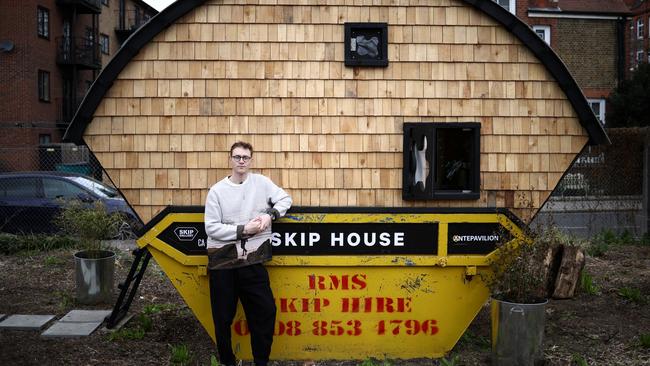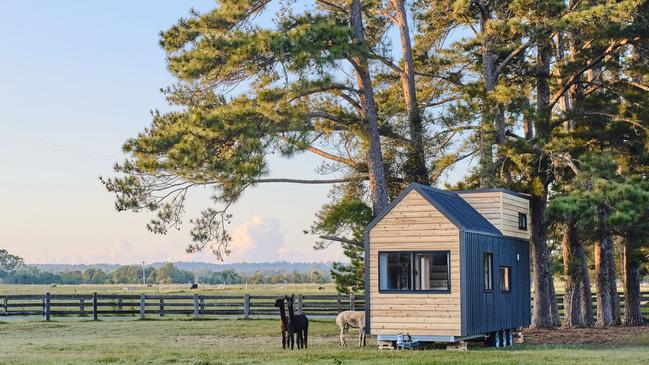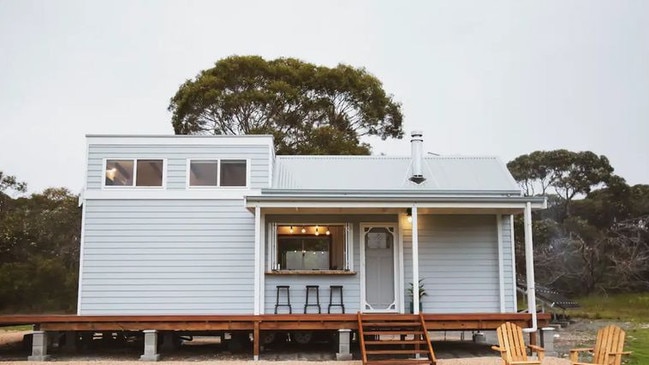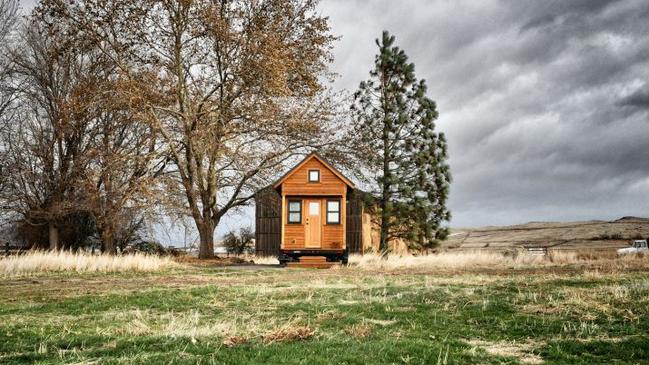The big problem holding tiny homes back from solving Australia’s housing crisis
Pocket-sized homes seem like a no-brainer for bolstering the nation’s house supply and affordability. But many tiny home occupiers are doing so under the radar. Here’s why.

Business
Don't miss out on the headlines from Business. Followed categories will be added to My News.
If someone told you they lived in a bin, you’d question not only their sanitation but sanity.
Yet, a video has gone viral online and attracted headlines across the world of a Londoner showing off his skip home to combat spiralling cost of living in England’s capital city.
Harrison Marshall’s home is a standard six cubic metre skip, measuring 3.7m by 1.6m, with a timber clad arched extension raised from its base, a bed, heater and small cooker. He says he has access to a portaloo and mostly showers at the gym or work.
Marshall says his project is about making a statement, which is not confined to the UK alone. Australia also has some of the highest cost of housing in the world.
This has sparked a blame game – from Martin Place to Canberra. Philip Lowe, who Labor dispatched as Reserve Bank governor after bungling interest rate forecasts, says monetary policy isn’t the cause of soaring house prices.
Meanwhile, Anthony Albanese threatened a double dissolution election during a stand-off with the Greens over his $10bn affordable housing package. The Prime Minister’s bluff worked.
But on the street, finding a place to hang your hat is scarce and the Australian dream of owning a quarter acre block in the suburbs is just that – a dream.
This has created a headache for chief executives at Australia’s biggest companies, such as NAB boss Ross McEwan who wants his senior leaders back in the office five days a week, putting an end to pandemic-era remote working.

During the Covid-19 years, workers – free from the requirement of trudging to the CBD every day – found they could access more affordable housing in the regions and dial into office instead. This is something that employers are now struggling to reverse amid flatlining productivity.
The escape to the country has also created another problem: surging regional property prices.
Many locals are now outpriced of the country towns they have called home for years while mini break-loving city slickers are scratching their heads wondering why it’s taking so long for their latte order to arrive; a lack of affordable accommodation is adding to chronic labour shortages.
Investment bank Jarden estimates that households nationally need an income of $140,000, or 40 per cent above the average, to afford a mid-priced property.
The affordability crisis is worst in Sydney, where a household income of $200,000, or 70 per cent higher than the national average, is needed to comfortably afford to buy a new home.
And while the rental crisis is showing signs of starting to ease, vacancy rates remain at about half of pre-pandemic levels as surging demand from renters still far outstrips supply, according to the latest PropTrack analysis.
But the answer could be simply downsizing expectations, or more specifically “going tiny”, making the same statement as Harrison Marshall with his skip home – proving not everyone needs a McMansion.
Tiny homes look great on Instagram, provide the perfect fodder for reality TV and present a potential solution for the nation’s housing crisis.

They’re also cheap, costing $80,000 to $150,000, and green; many homes are off grid and don’t use much energy anyway, given their smaller floor plan.
Like gypsy caravans, tiny homes can be moved around to a parent’s backyard or a vacant suburban block, helping plug demand where rents have soared to the point of becoming unaffordable.
Except they are not caravans. The tiny homes are real dwellings but under current laws they are classed as a caravan, not a freestanding home. This creates myriad problems.
They are not built to caravan standards, nor do they comply with the National Construction Code – given their small footprint requires design features such as steeper stairs than you would find in a conventional home – meaning owners can’t obtain building permits.
And this when what becomes a neat solution for Australia’s housing shortage falls over like a proverbial house of cards. No building permits mean that many tiny home occupiers are living “under the radar” having hardly any rights if a neighbour complains or a council officer comes knocking, ordering them to move on.

Australian Tiny House Association president Janine Strachan wants planning reform to fix this problem.
“We want to be able to see what we call a tiny house permitted parking spaces,” Strachan said.
“So a tiny house can be parked along on your property. It shows you with the permit conditions that says – how do you manage your wastewater? where do you dispose of your waste? Making sure that you’ve got offsets from the boundary fence so you’re not becoming a nuisance to your neighbour.
“Anywhere residential use is allowed, so should the occupation for a tiny house.”
Adding to tiny home occupier woes is that there is a legal loophole meaning they can rent them out on platforms like Airbnb but technically can’t live in them permanently.
“Tiny houses are being used everywhere for Airbnb and you could rent them out for 365 days of the year,” Strachan says.
“That’s allowed but you can’t have somebody living it for 365 days a year. That’s because it is accommodation as opposed to a dwelling.”

Complicating the decision to go further is that no state has any definitions in their building regulations for them.
“They are different to a granny flat and a bungalow and so on because of their ability to be moved – on wheels or skids,” Strachan says.
It is this portability that also makes getting building permits difficult – even if a tiny home complied with building regulations.
This is because many tiny home occupiers do not own the land their homes are situated on.
“A building permit goes to the landholder,” Strahan says. “Generally speaking, there are a few examples around Australia that the building permit might be issued to the structural owner occupier, like Bunnings, Officeworks – they don’t own the land, they lease the land under a long-term lease.
“But generally speaking, building permits go with the land owner and therefore, if I wanted to bring the tiny house on to your land, who gets a building permit? You do but it’s actually for my structure.
“So what we need is planning scheme reform across all of the various states because we want it done consistently, as opposed to a local council change.”
Originally published as The big problem holding tiny homes back from solving Australia’s housing crisis



